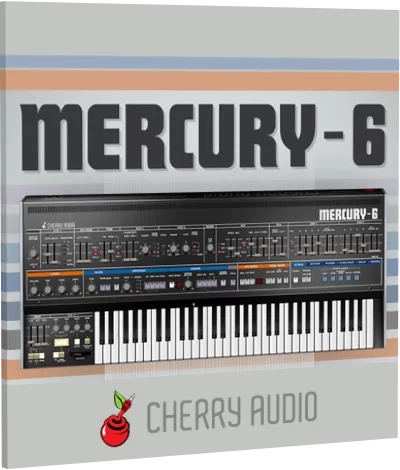Mercury-6 - это тщательное воссоздание аналогового синтезатора Jupiter-6, как раз к его 40-летию! Находящийся между более ранними моделями Jupiter-4 и Jupiter-8 только по названию, усовершенствованный Jupiter-6 иногда рассматривался как запоздалый выпуск. В наши дни он упорно продолжает оставаться одним из самых заметных и желанных классических синтезаторов Roland благодаря своему отличительному мрачному и сложному характеру. Mercury-6 отражает все исключительное в этой бесценной полифонической классике, расширяет набор ее экстраординарных функций для современного производства, рабочего процесса и прославляет новаторские инновации эпохи, которые навсегда изменили музыку.
Mercury-6 is a meticulous recreation of the Jupiter-6 analog synthesizer, just in time for its 40th anniversary! Sandwiched between the earlier Jupiter-4 and Jupiter-8 models in name only, the sophisticated Jupiter-6 has sometimes been considered a sleeper release. These days, it has persevered to become one of Roland's most notable and coveted classic synthesizers due to its distinctive dark and complex character. Mercury-6 captures all that is exceptional in this treasured polyphonic classic, boosts its extraordinary feature set for today's DAW production and workflow, and celebrates the ground-breaking innovation from the era that changed music forever.
If you've long yearned to explore the Jupiter-6, you'll love Mercury-6!
The Year Everything ChangedReleased in 1983 as a more affordable alternative to the flagship eight-voice Jupiter-8, the six-voice Jupiter-6 nevertheless staked out an essential position in the history of analog polysynths. Though similar in appearance and feature set, the Jupiter-6 stood apart from the Jupiter-8 in its sound and capabilities. Unlike earlier Roland polysynths with lowpass filters plus a rudimentary non-resonant highpass filter, the Jupiter-6 featured a true multimode filter with 24 dB/oct lowpass, 24 dB/oct highpass, or 12 dB/oct bandpass modes. This versatile filter design lent a more aggressive sound than previous Jupiters, making the Jupiter-6 a natural for cutting-edge techno and electro styles.
Though something of a "hidden feature," the Jupiter-6 VCOs supported multiple simultaneous waveforms, and its two LFOs and oscillator cross mod capabilities provided extensive modulation possibilities. Its earthshaking solo and poly unison modes enabled massive lead and bass sounds, and it was notably one of the first synthesizers to include the then-new MIDI protocol.
Although often praised for its harmonic complexity and ability to cut through a mix, the cost-cutting in the Jupiter-6 design resulted in some disadvantages. Output was mono only and it was limited to six-voice polyphony. The Jupiter-6 had an impressive (for the time) split keyboard and patch preset storage functionality, but this six-voice maximum hampered its potential. And though it was considerably less expensive than the Jupiter-8, its timing was ill-fated when the digital revolution was ignited by the release of Yamaha's revolutionary DX-7 FM digital synth the same year.
Despite its noteworthy character, the Jupiter-6 is not one of those synths immediately identified with recognizable sounds from hit songs. Nevertheless, it was the Jupiter-6 behind the bass line of Ray Parker Jr.'s classic "Ghostbusters," and it found purchase in the work of Human League, Tangerine Dream, Thomas Dolby, Trans-X, Vangelis, and Devo. In a testament to its staying power over the decades, its popularity grew in genres such as big beat, house, and techno through The Chemical Brothers, Moby, and The Crystal Method. Electronic music duo Orbital has been a vocal proponent of the Jupiter-6 and, more recently, it has been a significant part of the sound of Daft Punk and Junkie XL.
Mercury-6: 40 Years in the MakingCherry Audio's Mercury-6 brings the Jupiter-6 experience into the future and celebrates the invaluable contribution that MIDI itself has made to the music community over the past 40 years. Mercury-6 captures all that is exceptional in this classic and boosts the extraordinary feature set and functionality for today's DAW production and workflow. We've added velocity sensitivity, improved the split mode, and added a layer mode capable of stacking two different sounds simultaneously with per-layer stereo panning, detuning, and sustain. A panel control lets users easily select and navigate between these layers and includes a utility function for exchanging settings between the lower and upper layers, or even between presets. And with polyphony extended to 16 notes, Mercury-6 won't easily run out of voices.
We've reproduced the arpeggiator, including the hidden Down/Up mode of the original, and augmented it by adding a Random mode and MIDI tempo sync. A chord memory mode enables multiple notes to be stored and played back with a single key. We've improved the functionality of the LFOs with a retrigger for LFO-1 and an always-on option for LFO-2, both syncable to MIDI tempo.
We've also introduced an integrated studio-quality effects panel with brilliant-sounding distortion, phaser, flanger/chorus, delay, and reverb. With additional touches such as per-layer drift control, over 500 expertly designed presets, and flexible MIDI mapping, Mercury-6 will satisfy both vintage synth aficionados and today's music producer.





![Cherry Audio - Mercury-6 1.0.5.84 Standalone, VSTi, VSTi 3, AAX (x64) RePack by R2R [En]](https://i.ibb.co/rZybJQT/10.png)
![Cherry Audio - Mercury-6 1.0.5.84 Standalone, VSTi, VSTi 3, AAX (x64) RePack by R2R [En]](https://i.ibb.co/zXWHP4y/11.png)
![Cherry Audio - Mercury-6 1.0.5.84 Standalone, VSTi, VSTi 3, AAX (x64) RePack by R2R [En]](https://i.ibb.co/rxwrH2K/12.png)
![Cherry Audio - Mercury-6 1.0.5.84 Standalone, VSTi, VSTi 3, AAX (x64) RePack by R2R [En]](https://i.ibb.co/WcYg5q5/13.png)

